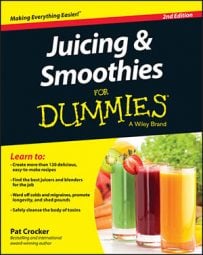Like their healthy juice counterparts, smoothies may be made from a wide array of organic, fresh fruits and vegetables. But smoothies are different from juices in two important ways: First, they’re made from the whole fruit or vegetable, so they keep the pure water, nutrients, and the fiber. Secondly, so many more natural and healthy ingredients like oats, nuts, seeds, herbs, and other natural supplements may be blended with smoothies.
They’re a good source of fiber
Fiber is the indigestible substance found only in plant foods, fruits, vegetables, grains, and legumes. Eating fiber is one of the easiest and least expensive ways to prevent disease and maintain health because it helps the body to eliminate waste materials and deadly toxins.
Water-soluble fiber lowers cholesterol and stabilizes blood sugar. Insoluble fiber increases stool bulk and promotes bowel movement, scouring the intestinal walls of toxic waste matter, promoting colon health by reducing the risk of diverticulosis and colon cancer.
Because they’re liquidized or finely chopped whole fruits and vegetables, smoothies contain both soluble and insoluble fiber from those plants. For an even extra fiber boost, add psyllium, nuts, seeds, cooked beans or lentils, bran, and oats to smoothies.
High-fiber fruits and vegetables include apples, oranges, berries, pears, figs, prunes, broccoli, cauliflower, Brussels sprouts, and carrots.
They’re a healthy substitute for empty-calorie drinks
It’s precisely because smoothies contain fiber and other slow-digesting ingredients like nuts, seeds, yogurt, coconut oil, milk, or tofu that they stay with you longer and satisfy you so much more than coffee or soda.
They make an excellent meal replacement
Busy times call for smart choices instead of fast foods. Smoothies are smart meal replacements because they’re high in nutrients. If you add small amounts of protein and even some grain to a vegetable smoothie, you can build that drink into a powerful meal replacement.
Excluding all your meals and taking only juices and smoothies isn’t wise, because, as nutritionists always point out, people need a wide variety of whole, natural foods. Excluding the other plant foods like whole grains, beans, legumes, nuts, and seeds means that you’re limiting the nutrients your body receives.
Breakfast and lunch are the best meals to use smoothies as a replacement for, especially if you usually skip breakfast and find yourself grabbing a fast meal for lunch.
They’re an easy way to take medicines, herbs, or supplements
Often the elderly or people recovering from surgery can handle smoothies long before they can tolerate solid foods. You can blend prescribed medications (only those that are meant to be taken with food) right into the smoothie, making them a nourishing drink for recovering patients. You also can boost the caloric content of smoothies by adding omega-3 rich oils, using whole milk, and adding protein sources. This is often the best way to bolster the diets of elderly and undernourished patients.
Healing herbs, tinctures, and teas can be used as smoothie ingredients. Healthy supplements like lecithin, bee pollen, goji berries, whey protein powder, activated almond butter, and green sprouts may be added to the blender along with the ingredients.

